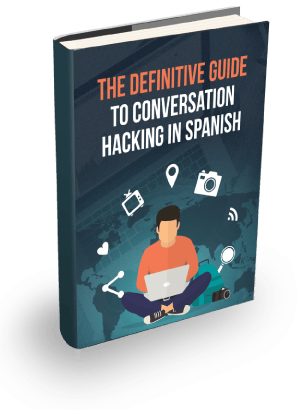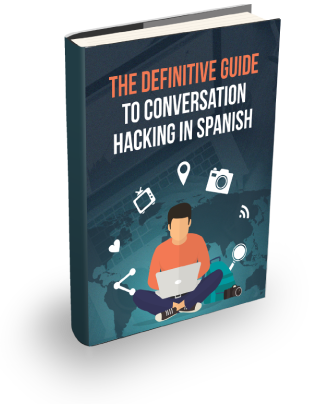This week on the Real Fast Spanish Tips podcast we will be looking at another Spanish past tense.
This Spanish past tense is called ‘Pretérito Indefinido’ or ‘Pasado Indefinido’.
As well as introducing a new past tense, we introduce a new guest. The new guest on the podcast is a friend of mine from Barcelona, Maria Piñero.
As Maria is from Barcelona, it means she can speak Catalan as well as Spanish.
I want to keep things simple, so for starters, I’m going to avoid asking Maria to show us her Catalan. But if we have enough requests from the listeners we might preview some Catalan in an upcoming episode.
I’m excited to have another guest from Spain to help us develop our skills further. Maria has a lot tutoring experience in Spanish and provides a great opportunity for some more Spanish conversation practice.
Now, with introductions aside, we can start to look at today’s discussion topic.
A few weeks ago we introduced the ‘past imperfect‘ Spanish tense. In tip number 15 ‘A Hack For The Past‘, we introduced the ‘present perfect’ tense. Make sure you know these two tenses first. So if you need to do some revision head back before continuing on. If you are happy with those tenses then you can look at the ‘Pretérito Indefinido’ tense or Spanish past simple tense.
Unlike the ‘past imperfect’ tense, the past simple tense is used for describing events that have a defined beginning and end.
If an event happened last week and it represented a specific moment in time you will use the past simple tense. If the event happened repeatedly in the past and had no defined start and finish you use the past imperfect tense.
And sometimes you will need to use the two tenses in combination. We will look at a few cases of this in the podcast.
Examples from the episode:
The past simple conjugation of ‘hablar’:
I spoke – Yo hablé.
You spoke – Tú hablaste.
He spoke – Él habló.
We spoke – Nosotros hablamos.
You-all spoke – Vosotros hablasteis.
They spoke – Ellos hablaron.
The past simple conjugation of ‘comer’:
I ate – Yo comí.
You ate – Tú comiste.
He ate – Él comió.
We ate – Nosotros comimos.
You-all ate – Vosotros conisteis.
They ate – Ellos comieron.
The past simple conjugation of ‘decir’:
I said – Yo dije.
You said – Tú dijiste.
He said – Él dijo.
We said – Nosotros dijimos.
You-all said – Vosotros dijisteis.
They said – Ellos dijeron.
She told me that… – Me dijo que…
I told her that … – Le dije que…
You told me…. – Me dijiste…
I met a guy and his name was Jose – Conocí un hombre y su nombre era Jose.
Last week, I was at the movies and the movie was very entertaining – La semana pasada estuve en el cine y la pelicula era muy entretenida.
Asian – Asiático.
Cinnamon – Canela.
You can get access to the Spanish podcast transcripts and English translations here.
Podcast: Play in new window




One of the things that makes learning Spanish difficult for
me is when phrases or sentences are translated using a different verb from what the meaning is as learned from verb books.
For instance, this is how I see these two sentences:
La semana pasada estuve en el cine.
Last week I was at the movies.
La semana pasada fui al cine.
Last week I went to the movies.
The first one was used in this lesson, and I’m wondering why the translation isn’t more accurate – or maybe it is in usage, but as a student, it is confusing.
I do enjoy these mini lessons, and I thank you for them.
Hi Sherri, thanks for the question.
I have updated the translation to “I was at the movies” to avoid confusion.
That said, I actually found this question quite difficult to answer.
It is important to note that accuracy of translation can be somewhat subjective. In other words, translation can be an art and not necessarily a science.
I think, in this instance, the translation of “estuve” is in fact much closer to “was” than “went”. However, “I was at the movies, and the movie was entertaining” sounds strange in English. We chose “I went to the movies” in English because it sounded more natural.
So, as you translate from one language to another, is it more accurate to have a word-by-word translation? Or is it more accurate to translate a complete idea (that could be an entire sentence) to a complete idea in another language, with both ideas making sense and sounding natural in each language?
An important language learning skill to develop is an ability to be flexible with translation because there are going to be even harder ideas to translate down the track, where understanding the concept in a general way maybe all you can do.
It sounds like your Spanish is excellent and improving, keep up the good work!
loved it thank you
Thanks Frances! 🙂
One of the most confusing things as a new learner is when I don’t know grammar enough to translate the names of tenses to what I do in english. So individual tense documents make sense when I read them, but when I look at a conjugation sheet like https://www.spanishdict.com/conjugate/amar compared to this https://www.wordreference.com/conj/esverbs.aspx Where is “Pretérito Indefinido – The Simple Spanish Past Tense”? (obviously I can look and figure it out!) But what i would like to see is an intro article to map all of the names for each tense, maybe noting which ones to focus on learning first, and which ones are really not used in day to day spanish (or perhaps only used in literary senses or historic writing). Not just an answer to which is spanish past tense, but a map that maybe shows a few examples of each, and all of the possible titles for a given tense, so THAT can go on the top of my notes and I can review it when I hit a reference that uses a different term than I am used to for something I already know. I try to build this up myself, but every time I think I have it, I get confused all over again. Especially since you have so many great example documents for each tense, an “index” tense document would be a great resource for helping form a mental map to start hanging these things on that native speakers generally don’t know themselves.
Thanks for the feedback Wayne 😊 I think the Spanishdict website is just using English names for the tenses but the Wordreference website uses Spanish names and you can hover the mouse over the “i” to get the different names in Spanish for the tense (since different countries use different names for the same tense).